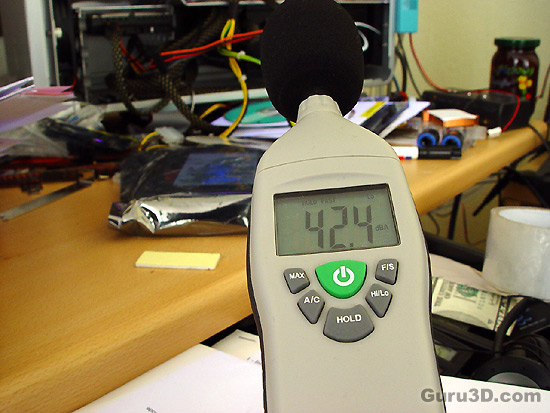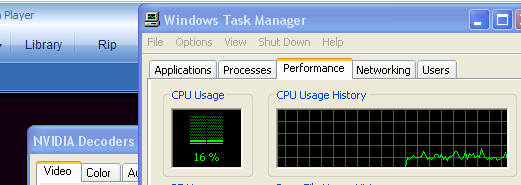Page 4
Noise Levels coming from the graphics card
When graphics cards produce a lot of heat, usually that heat needs to be transported away from the hot core as fast as possible. Often you'll see massive active fan solutions that can indeed get rid of the heat, yet all the fans these days make the PC a noisy son of a gun. I'm doing a little try out today with noise monitoring, so basically the test we do is extremely subjective. We bought a certified dBA meter and will start measuring how many dBA originate from the PC. Why is this subjective you ask? Well, there is always noise in the background, from the streets, from the HD, PSU fan etc etc, so this is by a mile or two not a precise measurement. You could only achieve objective measurement in a sound test chamber.
The human hearing system has different sensitivities at different frequencies. This means that the perception of noise is not at all equal at every frequency. Noise with significant measured levels (in dB) at high or low frequencies will not be as annoying as it would be when its energy is concentrated in the middle frequencies. In other words, the measured noise levels in dB will not reflect the actual human perception of the loudness of the noise. That's why we measure the dBa level. A specific circuit is added to the sound level meter to correct its reading in regard to this concept. This reading is the noise level in dBA. The letter A is added to indicate the correction that was made in the measurement. Frequencies below 1kHz and above 6kHz are attenuated, where as frequencies between 1kHz and 6kHz are amplified by the A weighting.
| TYPICAL SOUND LEVELS | ||
| Jet takeoff (200 feet) | 120 dBA | |
| Construction Site | 110 dBA | Intolerable |
| Shout (5 feet) | 100 dBA | |
| Heavy truck (50 feet) | 90 dBA | Very noisy |
| Urban street | 80 dBA | |
| Automobile interior | 70 dBA | Noisy |
| Normal conversation (3 feet) | 60 dBA | |
| Office, classroom | 50 dBA | Moderate |
| Living room | 40 dBA | |
| Bedroom at night | 30 dBA | Quiet |
| Broadcast studio | 20 dBA | |
| Rustling leaves | 10 dBA | Barely audible |
We startup a benchmark and leave it running for a while. The fan rotational speed remains constant as the ForceWare driver can not control the fans (they are connected straight to the PSU by Molex).
We take the dBA meter, move away 75 CM and then aim the device at the active fan on the graphics card. We measure roughly 42 dBa which is to be considered a quiet noise level coming from the PC yet also a norm as most of our tests end up at this sound level. Again, this is a very subjective test and that dBa level includes all noise in the environment.
So the TEC/peltier cooler is making as much noise as pretty much any standard cooling method.

PureVideo HDStandard and High definition Decoding
With each "new" product I always include this little snippet of text as there's a neat little trick you can pull with NVIDIA GeForce graphics cards starting at series 7. NVIDIA made the GPU (the graphics chip) an important factor in en/decoding video streams. With a special software suite called PureVideo you can offload the video encoding/decoding process from the CPU towards the GPU, and the best thing yet it can greatly enhance image quality.
PureVideo HD is a video engine built into the GPU (this is dedicated core logic) and thus is dedicated GPU-based video processing hardware, software drivers and software-based players that accelerate decoding and enhance image quality of high definition video in the following formats: H.264, VC-1, WMV/WMV-HD, and MPEG-2 HD.
So what are the key advantages of PureVideo? In my opinion two key factors are a big advantage. To offload the CPU by allowing the GPU to take over a huge sum of the workload. HDTV decoding through a TS (Transport Stream) file, for example, can be very demanding for a CPU. These media files can peak to 20 Mbit/sec easily as HDTV streams offer high-resolution playback in 1280x720p or even 1920x1080p without framedrops and image quality loss.
By offloading that big task for the bigger part of the graphics core, you give the CPU way more headroom to do other which makes your PC actually run normal. The combination of these factors offer you stutter-free high quality and high resolution media playback. All standard HDTV resolutions of course are supported, among them the obvious 480p, 720p and 1080i modes and now also 1080P (P=Progressive and I=Interlaced). Ever since the Series 75 ForceWare driver, PureVideo is doing something I've been waiting on for quite some time now, 2-2 pull down which converts 24 frames per second to 50 frame per second PAL. But along with this the new G80 series (and this'll work on G70 as well) will offer HD noise reduction, which is great feature with older converted films. And this is where we land at Image Quality. PureVideo can offer a large amount of options that'll increase the IQ of playback. This can be managed with a wide variety of options. Obviously NVIDIA has some interesting filters available in the PureVideo suite like advanced de-interlacing, which can greatly improve image quality while playing back that DVD, MPEG2 or TS file (just some examples). Aside from that, things like color corrections should not be forgotten. All major media streams are supported by NVIDIA with PureVideo. And yes High Definition H.264 acceleration, which will become a big, new and preferred standard, is also supported.
Paradox: You do not need PureVideo for HDTV playback and connectivity, but it is recommended if you have that dedicated hardware in your system anyway.
 Once you offload media streams to the graphics processor things look much better with the help of PureVideo. Have a look at the graph below where you are monitoring the CPU at work at roughly 12-20% decoding a HDTV .TS file:
Once you offload media streams to the graphics processor things look much better with the help of PureVideo. Have a look at the graph below where you are monitoring the CPU at work at roughly 12-20% decoding a HDTV .TS file:
Indeed, a huge improvement over standard decoding. We are now at a CPU utilization of 12-20%, really nice for a HD MPEG2 stream. The processor is almost doing nothing. This for example is a Transport Stream file with a HDTV resolution of 1920x1080i.
In combo with the new drivers you can now also decode High Definition H.264 streams. H.264 is a compression algorithm used to transmit video efficiently between endpoints. This algorithm is seen as the replacement for its predecessor, H.263. What is different about H.264 is that it promises to deliver high quality video, H.264 also enables very high quality encoding, producing way better results than even MPEG2 and of course HDTV levels. These GeForce series 7 and 8 cards can also manage 3:2 and 2:2 pull down (inverse telecine) of SD and HD interlaced content.
New with the introduction of GeForce 8800 we see a 10-Bit display processing pipeline and also new post-processing options (works for GeForce series 7 as well):
- Adds VC-1 & H.264 HD Spatial-Temporal De-Interlacing
- Adds VC-1 & H.264 HD Inverse Telecine
- Adds HD Noise Reduction
- Adds HD Edge enhancement
With the new PureVideo engine the popular benchmark tool HQV now will score 128 points, which is near perfect.
Software like WinDVD, PowerDVD and Nero showtime will support PureVideo from within their software. You can also buy the PureVideo software for a few tenners at NVIDIA after which MediaPlayer or Media Center will work with it flawlessly.
To give you an idea how intensely big one frame of 1920x1080 is with a framerate of 24 frames per second. Click on a the two example images above. Load them up, and realize that your graphics card is displaying that kind of content 24 times per second, while enhancing them in real-time.


